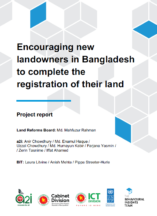This project was the first we completed in Bangladesh with a2i, the Government’s flagship digital programme.
It looked to support an ambitious national programme of land reform led by the Ministry of Land, which relies in part on building systems to improve land record-keeping, hoping to i) simplify processes for all, ii) offer better protection for citizens, and iii) improve state monitoring of land ownership and taxes.
As a first step towards these wider changes, the Government has built a new digital service for “land mutation”. Land mutation, which is the last step in the land registration process, requires that a new landowner approaches the local land office to update their name on the Record of Rights. Mutation is compulsory and should happen immediately after having received a certified deed for the purchase or transfer of a piece of land.
However, in practice, most mutations currently occur only when the landowner requires proof of land ownership, e.g. to sell the land, obtain a loan, or when a dispute has already arisen. As a result, many land records remain out of date – and many landowners expose themselves to risks that they might not be aware of, such as seeing someone claim ownership over their land, or even the previous owner selling the same piece of land twice.
In this trial, we developed cost-effective communications to encourage new landowners to apply for mutation immediately after they purchase or receive a new piece of land, and to do so via the new e-mutation system. We developed a leaflet designed to be timely (it was given right after certification hearings); to be easy-to-use, including simple illustrations and checklists; to make mutation attractive by calling onto the identity of recipients as landowners and highlighting that mutation has been adopted by a large number of people across the country; and to be scalable if proven successful.
We rolled out a large-scale trial of this leaflet in 46 sub-districts across Bangladesh in 2018, targeting more than 30,000 land transfers which required to apply for land mutation. Thanks to complex data collection and merging conducted by a2i, we were able to collect some of the first data on mutation rates in Bangladesh, showing that approximately 30% of new landowners applied for mutation within 3 months, 15% of which applied via e-mutation.
This trial, owing to the complexity of field operations, suffered from several data collection issues which limited our ability to draw strong conclusions about the effect of our behavioural intervention. We, however, observed directionally promising effects of the leaflet on the likelihood that citizens apply via emutation, which suggests that citizens might indeed lack information on this service.
We propose in this report a series of recommendations for future testing, but also to bridge the coordination gap which still hampers the success of many land reform initiatives





